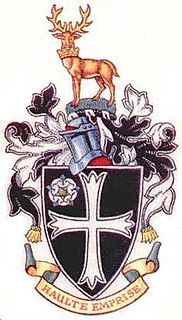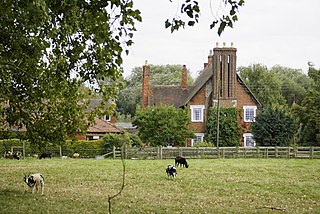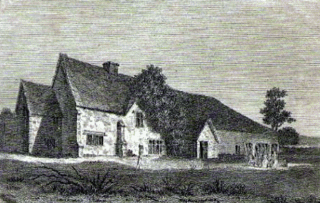
Haltemprice is an area in the East Riding of Yorkshire, England, directly to the west of Hull. Originally an extra-parochial area, it became a civil parish in 1858, in 1935 it was expanded by the combination of the urban districts of Cottingham, Anlaby, and Sculcoates to form a new urban district; the district included the villages of Anlaby, Cottingham, Hessle, Kirk Ella, Skidby, West Ella and Willerby. Urban districts were abolished 1974.

Littlemore is a district and civil parish in Oxford, England. The civil parish includes part of Rose Hill. It is about 2 1⁄2 miles (4 km) southeast of the city centre of Oxford, between Rose Hill, Blackbird Leys, Cowley, and Sandford-on-Thames. The 2011 Census recorded the parish's population as 5,646, with the electoral ward having a total population of 6,441.

Arthington Priory was an English monastery which was home to a community of nuns in Arthington, West Yorkshire, founded in the mid-12th century. The priory land is occupied by a residence called "Arthington Hall", which was built around 1585, and little, if anything, remains of the priory. The site of the priory church is possibly now occupied by a farmhouse called The Nunnery. The community was the only one of nuns of the Cluniac congregation in Yorkshire and one of two in England. It was established through a grant by Peter de Arthington.

Marton-cum-Moxby is a civil parish in North Yorkshire, England. The population of the civil parish is less than 100 at the time of the 2011 Census. Details were included in the civil parish of Farlington, North Yorkshire. It is situated to the east of the villages of Stillington and Farlington, near Easingwold. Marton-cum-Moxby consists of the hamlets of Marton-in-the-Forest and Moxby. Today both Marton and Moxby are overwhelmingly agricultural in character.

Ickleton Priory was a Benedictine priory of nuns at Ickleton, Cambridgeshire, England. It was established in the middle of the 12th century and suppressed in the Dissolution of the Monasteries in 1536.
Gokewell Priory was a Cistercian Catholic priory in Broughton, Lincolnshire, England..
Arden Priory was a priory near to Hawnby in the Ryedale district of North Yorkshire, England. A Benedictine nunnery has been recorded here since 1150 and at the time of its dissolution in 1536 it had 6 nuns, one Prioress and an elderly sister. They were aided by sixteen servants.

Handale Priory was a priory of Cistercian nuns in Handale, North Yorkshire, England. It was founded in 1133 by William, son of Roger de Percy, and was dissolved in 1539. A fishpond survives and a farmhouse built on the site in the 18th century may incorporate part of the priory.

Marrick Priory was a Benedictine nunnery in Richmondshire, North Yorkshire, England, established between 1140-1160 by Roger de Aske. The parish Church of the Virgin Mary and St. Andrew and 400 acres of local land also belonged to the priory, which thrived until the 16th century, in spite of the depredations of marauding Scots.
Moxby Priory is the commonly used name of the former Augustinian nunnery of S. John the Apostle in today's parish of Marton-cum-Moxby, North Yorkshire, England.

Rosedale Priory was a priory in Rosedale Abbey, North Yorkshire, England that was founded c. 1150–1199. By the time the priory was suppressed in 1535, it had one prioress and eight nuns. The religious house in Rosedale was a priory and not an abbey, despite the village being given the name Rosedale Abbey, and it is unclear why this came about.

Farewell Priory was a Benedictine nunnery near Lichfield in Staffordshire, England. Although it received considerable episcopal support, it was always small and poor. It was dissolved in 1527 as a by-product of Cardinal Wolsey's scheme to establish a college within Oxford University.

Nuneaton Priory was a medieval Benedictine monastic house in Nuneaton, Warwickshire, England. It was initially founded by Robert de Beaumont and Gervase Paganell in 1153 at Kintbury in Berkshire as a daughter house of Fontevraud Abbey in France. Soon afterwards, in around 1155 the foundation was moved to Etone in Warwickshire, which subsequently became known as Nuneaton.
Pinley Priory, also called Pinley Abbey, was a Cistercian nunnery in the parish of Rowington in Warwickshire, England. It was founded in the early 12th century and dissolved in 1536.

Studley Priory, Warwickshire, was a priory in Studley, Warwickshire, England.

Wroxall Priory was a medieval monastic house in Wroxall, Warwickshire, England.

St Mary's Priory was a Benedictine priory of nuns at Kington St Michael in Wiltshire, England. Founded before 1155, the priory was dissolved in 1536.
Cookhill Priory was a Cistercian nunnery near Cookhill in Worcestershire, England. It is said to be founded by Isabel de Mauduit, wife of William de Beauchamp, 9th Earl of Warwick in 1260, but it most likely dates to some years before then. It is on record that she was buried at Cookhill when she died, and that she had become a nun there by the time of his death in 1298. A tomb with a broken dedication was still present in the chapel in seventeenth century.
The former Priory of Douglas was a Cistercian monastery of nuns on the Isle of Man, apparently founded in the reign of Rǫgnvaldr Guðrøðarson, King of the Isles.

Black Ladies Priory was a house of Benedictine nuns, located about 4 km west of Brewood in Staffordshire, on the northern edge of the hamlet of Kiddemore Green. Founded in the mid-12th century, it was a small, often struggling, house. It was dissolved in 1538, and a large house was built on the site in Tudor and Jacobean styles by the Giffard family of Chillington Hall. Much of this is incorporated in the present Black Ladies, a large, Grade II*-listed, private residence.














